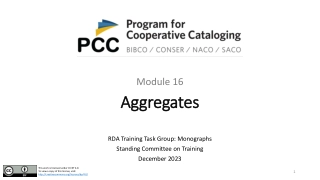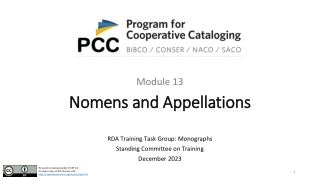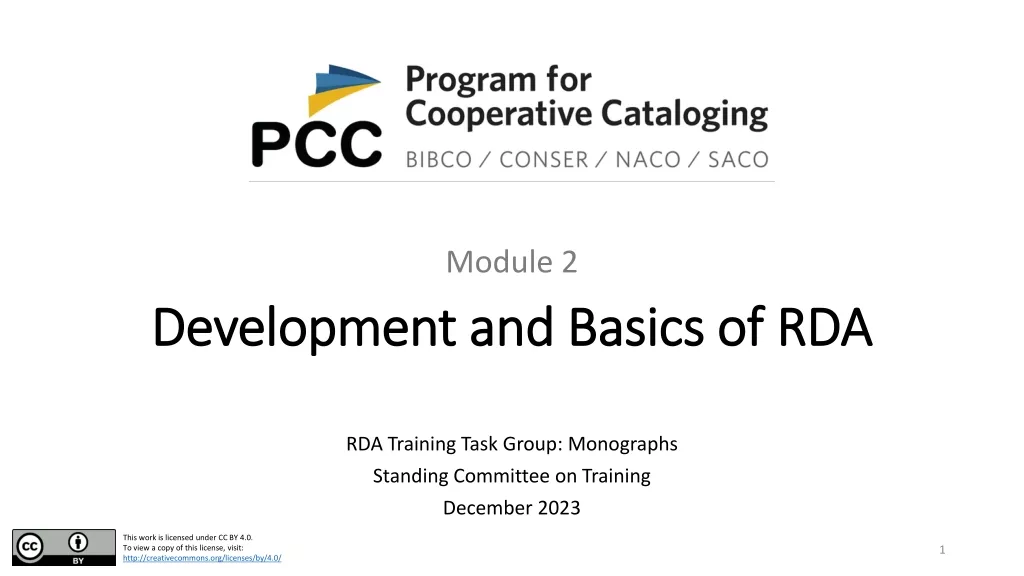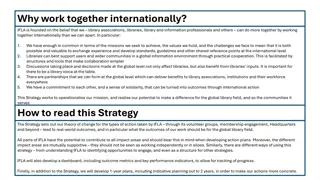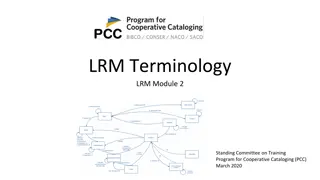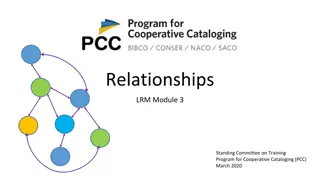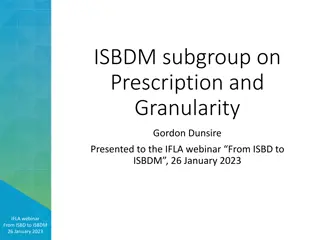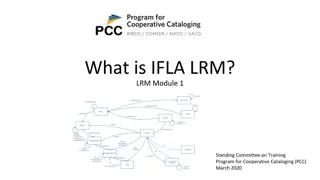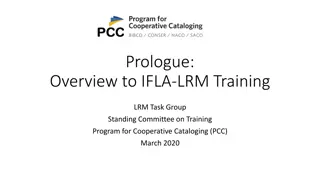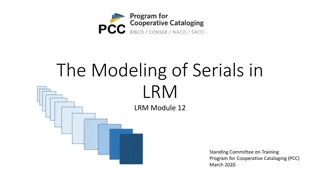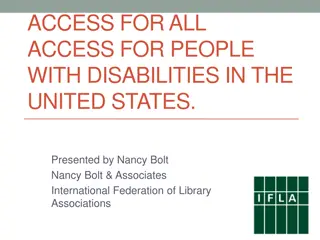Understanding Aggregates in RDA Training: A Comprehensive Overview
Explore the concept of aggregates in RDA training through this detailed module covering types of aggregates, LRM model, user-driven examples, and considerations in describing aggregates. Gain insights into collection, augmentation, and parallel aggregates with practical scenarios.
2 views • 40 slides
Understanding Nomen Entity in RDA Training Module
Explore the development of the Nomen entity in RDA training, differentiating nomen and nomen strings, identifying RDA elements for describing a nomen, and examining relationship elements linking RDA entities with nomens. Delve into the origins and attributes of nomens as defined in FRBR and FRAD sta
1 views • 48 slides
Evolution of Cataloging Standards: From Cutter's Objects of the Catalog to RDA Development
The evolution of cataloging standards reflects a rich history dating back to the 19th century, from Cutter's Objects of the Catalog to the development of official RDA. Key milestones include the 3R Project, LRM, RDA Registry, and the shift in cataloging rules driven by changing user needs and digita
6 views • 38 slides
Working Together Internationally: IFLA's Vision for Global Library Engagement
IFLA emphasizes the value of international collaboration among library associations, libraries, and information professionals to exchange experiences, develop standards, and address common challenges. By working together, libraries can enhance user support, foster global information access, and advo
1 views • 6 slides
Understanding Basic Terminology in Library Information Systems
Explore key terminology like Class, Entity, Superclass, Subclass, and more from the LRM Module. Learn about the definitions and relationships of these essential concepts in the context of library information systems.
0 views • 17 slides
Understanding Relationships in Bibliographic Universe
Relationships in bibliographic universe connect entities, providing context through entity-relationship models like IFLA LRM. Learn key terms, principles, and diagrams to identify relationships defined in IFLA LRM. Explore domains, ranges, inverse, recursive, and symmetric relationships. Enhance you
1 views • 23 slides
ISBD Manifestation Granularity and Prescription in ISBDM
The ISBD Subgroup on Prescription and Granularity, presented in the IFLA webinar, focuses on developing specific aspects of the draft ISBD for Manifestation. This group aims to maintain a prescriptive approach to maximize consistency, re-usability, local utility, and global interoperability. The dis
0 views • 9 slides
Understanding IFLA LRM: A Conceptual Reference Model
IFLA LRM, created by the International Federation of Library Associations and Institutions, consolidates FRBR, FRAD, and FRSAD models into a coherent framework. It aims to structure bibliographic data logically and inclusively, focusing on end-user needs and tasks. The model describes interrelated e
0 views • 11 slides
Introduction to IFLA-LRM Training Program for Cooperative Cataloging (PCC)
This training program, conducted by the LRM Task Group of the Standing Committee on Training Program for Cooperative Cataloging (PCC) in March 2020, aims to provide an overview of the IFLA Library Reference Model (LRM) and its primary concepts. The training is structured with 12 modules covering dif
0 views • 5 slides
IFLA Guidelines for Library Services to Prisoners - Overview
The IFLA Guidelines for Library Services to Prisoners, developed by Dr. Jane Garner from Charles Sturt University, aim to inspire best practices in libraries serving incarcerated individuals. Covering topics such as management, budgeting, staffing, facilities, and collaboration with public libraries
1 views • 20 slides
Modeling of Serials in IFLA LRM Module 12 by PCC
Serials in library cataloging are modeled as complex constructs in IFLA LRM with considerations for whole/part and aggregation relationships. This module explores the intricacies of serial manifestations, issue manifestations, and the concept of WEM lock, providing insights into collocating closely-
0 views • 15 slides
Libraries' Commitment to Accessibility for All in the United States
Nancy Bolt & Associates, in collaboration with the International Federation of Library Associations (IFLA), presented on the importance of access for people with disabilities in the United States. The presentation highlighted the commitment of libraries to ensuring accessibility for all individuals,
0 views • 15 slides
